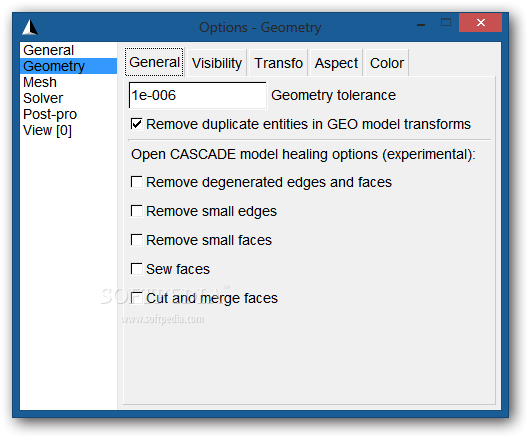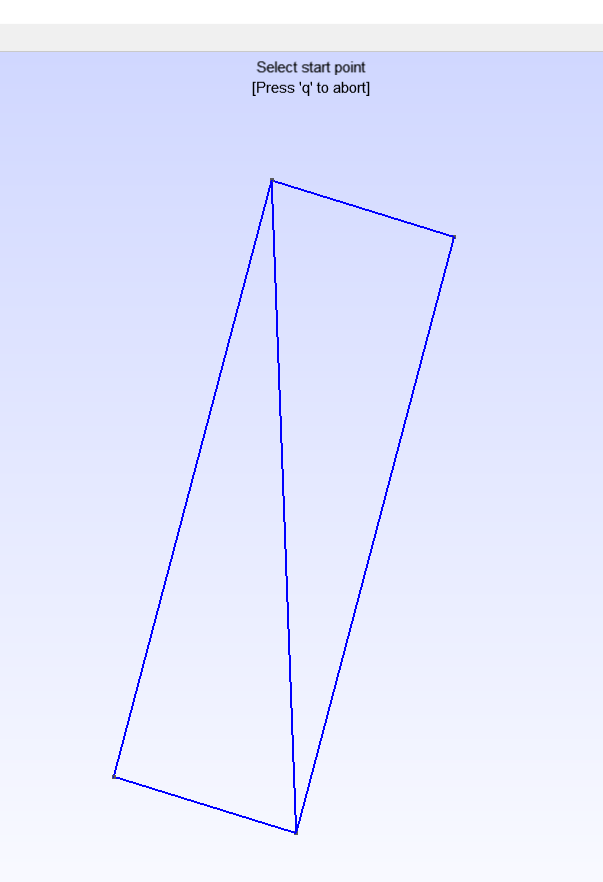

- #EXPORT OPENCASCADE MESH GMSH HOW TO#
- #EXPORT OPENCASCADE MESH GMSH MANUAL#
- #EXPORT OPENCASCADE MESH GMSH DOWNLOAD#
zero, which satisfies the boundary conditions.Īrray ess_bdr(pmesh.bdr_attributes.Max()) Define the solution vector x as a parallel finite element grid Thus, in order to set it to one, modify section 10 in ex1p.cpp: // 10. If we run ex1.cpp without modifications, a zero value will be assigned to the newly defined surface. The line should be inserted in any place after the definition of geometrical surface 7, e.g., after the boolean operation defining the final geometry. The following snippet defines these objects: SetFactory("OpenCASCADE") Ĭylinder(2) = We will start with the definitions of a cube with edge length L=1 and two cylinders with a radius L/10 and heights equal to L.
#EXPORT OPENCASCADE MESH GMSH DOWNLOAD#
If Gmsh is not installed on your local machine, please download it and follow the installation instructions. Users familiar with Gmsh can skip the first steps and download already prepared geometries for meshing. Many examples together with documentation on the input syntax can be found at the Gmsh website. Here, however, we focus on simpler examples showing the process of generating meshes suitable for MFEM and not on the actual geometry. CAD models in IGES or STEP formats can be imported by the CAD engine of Gmsh, meshed, and prepared as inputs to the MFEM examples. The geometry can be generated using the Gmsh graphical user interface (GUI), simple text editors such as Vi/Vim/Emacs, or using more sophisticated CAD tools such as SolidWorks or Autocad. The input to Gmsh can be a simple text file that provides a description of the geometry of the finite element model. Gmsh is an open-source, freely available mesh generation tool with built-in computer-aided design (CAD) functionality and a postprocessor.
#EXPORT OPENCASCADE MESH GMSH HOW TO#
In this section we demonstrate the common steps necessary for generating high-quality meshes in Gmsh and Cubit and how to use them in finite element simulations with MFEM. I tried with extruding the surface mesh along the normals to create a boundary layer with prisms but this creates conflicts of advancing fronts at the intersection between the wing and the fuselage (in the part after the ogive) and does not give me enough points in the viscous layer.And Finite Element Basics pages before this lesson.
#EXPORT OPENCASCADE MESH GMSH MANUAL#
Please note that I need to create a manual boundary layer from the surface so I would need to have transfinite recombined.

If I extrude the line to create the ogive by asking to extrude the mesh, I get a structured mesh in the ogive, but this prevents me to apply the transfinite on the cylindrical surface adjacent to the ogive. Error : Surface 1 is transfinite but has 1 holes While trying to create a transfinite recombined mesh over it I get the error message: This ogive is created by extruding by revolution around its longitudinal axis. I have vehicle with an ogive at the nose. (Incidentally I tried another option with the Built In engine + surface filling but I was not getting a curvature that was smoothly connecting with the rest of the surface but was “bulging” out). I am using the OCC engine: I need it since I must use the boolean operation to create the root of the biconvex wing along the cylindrical fuselage. I would like to kind ask for support in solving an issue with gmsh with which I have been struggling from many days now.

Transfinite Surface with OpenCASCADE engine


 0 kommentar(er)
0 kommentar(er)
